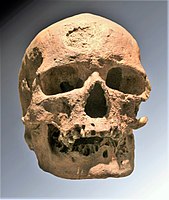Cro-Magnon rock shelter
Abri de Cro-Magnon | |
Cro-Magnons | |
| Site notes | |
|---|---|
| Excavation dates | 1868+ |
| Archaeologists | Louis Lartet |
| Public access | Yes |
| Website | Official website |
| Type | Cultural |
| Criteria | i, iii |
| Designated | 1979 (3rd session) |
| Part of | Prehistoric Sites and Decorated Caves of the Vézère Valley |
| Reference no. | 85 |
Cro-Magnon (/kroʊˈmænjən/ ⓘ, US: /-ˈmæɡnən/; French: Abri de Cro-Magnon French pronunciation: [kʁomaɲɔ̃])[note 1][2][3] is an Aurignacian (Upper Paleolithic) site, located in a rock shelter at Les Eyzies, a hamlet in the commune of Les Eyzies-de-Tayac-Sireuil, Dordogne, southwestern France.[4]
Most notably, it is the site of the discovery of
Human remains


In 1868, workmen found animal bones, flint tools, and human skulls in the rock shelter. French geologist Louis Lartet was called for excavations, and found the partial skeletons of four prehistoric adults and one infant, along with perforated shells used as ornaments, an object made from ivory, and worked reindeer antler.
These "Cro-Magnon men" were identified as the prehistoric human species of Europe, as distinct from
Cro-Magnon 1 consists of a skull and partial skeletal remains belonging to a male individual, approximately 40 years old.
Cro-Magnon 2 is a partially preserved female skull with marked facial similarities to Mladeč 2.[12]
Cro-Magnon 3 is a partial skull of a male adult.
The remains are thought to represent adults who died at an advanced age, who were placed at the site, along with pieces of shell and animal teeth in what appear to have been pendants or necklaces, in an apparent intentional burial. The presence of necklaces and tools suggests the concept of grave goods.[13]
Analysis of the
Compared to Neanderthals, the skeletons showed the same high forehead, upright posture and slender (gracile) skeleton as modern humans. The other specimens from the site are a female, Cro-Magnon 2, and male remains, Cro-Magnon 3.
See also
 France portal
France portal- Archaic human admixture with modern humans
- List of human evolution fossils
- Neanderthal extinction
- Peopling of Europe
Notes and references
Notes
References
- ^ Google Maps Elevation Finder
- ^ "Cros". Retrieved 2014-08-15.
- ^ "The Cro-Magnon Shelter". Retrieved 2014-08-15.
- ^ (in French) Prehisto-France[permanent dead link]
- ^ Cro-Magnon 1: 27,680 ± 270 BP "Evolution: Humans: Origins of Humankind". Pbs.org. Retrieved 2011-10-05.
- ^ "Prehistoric Sites and Decorated Caves of the Vézère Valley". UNESCO World Heritage Centre. United Nations Educational, Scientific, and Cultural Organization. Retrieved 9 October 2021.
- ^ Edouard Lartet and Henry Christy; edited by Thomas Rupert Jones. Reliquiæ aquitanicæ : being contributions to the archæology and palæontology of Périgord and the adjoining provinces of southern France (1875), Plate V: Female Cro-Magnon skull in two views.
- OCLC 34148636.
- ^ (in French) Abri Cro-Magnon - Hominidés.com
- ^ "Cro-Magnon 1". Archived from the original on July 7, 2006. Retrieved 14 July 2006.
- ^ Turchin VF. The Phenomenon of Science. Chapter 5. Retrieved April 17, 2011.
- ^ Maria Teschler-Nicola, Early Modern Humans at the Moravian Gate: The Mladec Caves and their Remains (2007), p.318.
- ^ a b "Human Evolution by The Smithsonian Institution's Human Origins Program". Museum of Natural History. Archived from the original on July 7, 2006.
- PMID 29619955.
External links
- Cro-Magnon 1: Smithsonian Institution – The Human Origins Program
